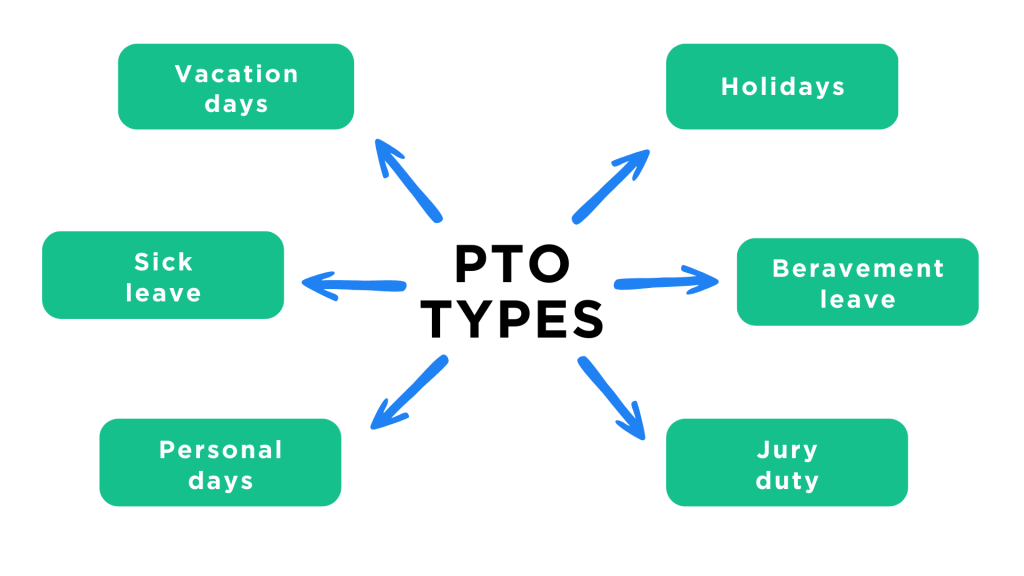Balancing work and personal life can feel like juggling. Sometimes, work takes over, leaving little room for personal time, which can be tough on both productivity and mental health. So, how do modern companies tackle this? They offer paid time off (PTO) to their employees. This approach benefits both the company and its workers. Wondering why? Let’s find out together!
Contents:
1. What is PTO?
3. PTO Policy
Key takeaways:
- PTO stands for Paid Time Off and is a policy that allows employees to take paid time off.
- The different types of PTO include vacation days, sick leave, personal days, holidays, bereavement leave, and jury duty.
- Employees typically receive a certain number of paid time off days each year, which they can accumulate over time.
- The specifics of a PTO policy can vary depending on the size of the company, its location, and how long the employee has been with the company.
What is PTO?
Let’s start with the basics: What is PTO? As we said earlier, PTO meaning is pretty simple, it stands for paid time off. It’s a benefit that lets employees take time off work while still getting paid. Many companies offer this option, because it helps employees maintain a good work-life balance and be more productive, which can have a positive impact on the company’s state.
Typically, employees receive a set number of PTO days within a specific period, such as three months or a year. To make things even easier, many companies provide systems for PTO tracking.
💡About 65% of employees experience burnout and lose interest in work. This is normal because it’s how the human mind works. Modern employers understand this, so they give employees the opportunity to rest and recharge, without losing money, which can also cause stress.💡
Time Off: Types of PTO
Now that we know what the meaning of paid time off is, it’s time to explore it types:
- Vacation days
Vacation days are days off that an employee can use for rest, travel, or any personal reason, usually within 1-2 weeks.
- Sick leave
An employee may take time off in the event of illness or injury. Sick leave can also be taken to care for an immediate family member who is sick or injured. For example, if an employee comes down with the flu or sprains an ankle, they can use sick leave to recover at home.
- Personal days
An employee may take time off for personal reasons, such as to attend to personal matters, run errands, or deal with unexpected situations. Thus, an employee might use a personal day to visit the doctor, do home repairs, or deal with sudden family problems.
- Holidays
These are days off that an employee can take on public holidays such as Christmas, New Year’s Day, or Independence Day. This is quite common since many holidays are official days off.
- Bereavement leave
This is time off that an employee can take to grieve the loss of an immediate family member. Such situations can greatly undermine the mental health of an employee and make his work simply impossible, which is why paid bereavement leave is necessary and provided for by lots of companies.
- Jury duty
This is a leave that an employee can take when called to serve on a jury. An employee receives a jury summons, they’re legally obligated to serve. During this time, the employee may take leave from work to fulfill their civic duty.

How does PTO work?
Companies usually provide employees with a specific number of annual PTO days, earned based on the hours served in a company. For example, imagine a company, where an employer might give an employee 15 days of PTO per year, which breaks down to 1.25 days per month (15 days / 12 months = 1.25 days per month). The employer sets the number of PTO days, but it’s important to know how to calculate them to know how and when you can use them.
In most organizations, there are policies that limit how many PTO days employees can roll over each year. This limit might start from the company’s fiscal year, the calendar year, or the employee’s hire date.
In the corporate world, long-term employees often get to accrue more PTO days. Some companies also allow senior employees to carry forward more PTO hours to the next year.
PTO Policy
With a PTO policy, both the employee and the employer need to know how it works and what details it covers. APTO policy may be simple for a small business, while large businesses operating in different states or countries may have different policies depending on location. PTO policy usually gives clear answers to the following questions:
- What qualifies as paid leave?
- Who is eligible for PTO, and when can it begin?
- How can you earn or accumulate PTO?
- How should you organize your time off?
- What happens to unused PTO: does it roll over to the next year, expire, or are you reimbursed for it at the end of the year?
- Is it mandatory to pay PTO when terminating an employee?
- Does the policy comply with state and local leave laws, such as sick leave requirements?
- How do employees submit their PTO requests? (email, HR software, calendar requests, etc.)
Each organization can specify when it’s appropriate to use PTO, such as in the event of a family crisis. There may also be certain provisions, such as not being able to take two days off in a row as personal days.
Benefits of Paid Time Off
You might think, the benefits of paid time off for employees are clear: they can take a break from work while still receiving their salary. But what advantages are there for employers? Let’s figure it out.
Comparison: meaning of PTO for employees and employers
| Benefits of PTO for Employees | Description | Benefits of PTO for Employers | Description |
| Rest and relaxation | Allows employees to take a break from work and recharge, reducing stress and preventing burnout. | Attracting and retaining talent | Makes the company more attractive to job seekers and helps in recruiting top talent. |
| Improved work-life balance | Helps employees achieve a better work-life balance, allowing more time for personal matters. | Increased productivity | Well-rested employees are more productive and perform better at work. |
| Increased job satisfaction | Leads to higher job satisfaction, increasing motivation, productivity, and loyalty to the company. | Reduced absenteeism | Reduces unscheduled absences as employees are more likely to take time off when needed. |
| Health and well-being | Enables employees to take time off when sick or injured, promoting better overall health. | Improved morale | Shows that the employer values employee well-being, improving morale and job satisfaction. |
Book a seat at our Weekly Public Demo or Themed Webinars to learn how to simplify your business workflows with Synder.
Conclusion
Every employee deserves to feel comfortable in their job without sacrificing mental health or personal interests. Understanding the definition and benefits of PTO is a must. A well-crafted paid time off policy helps employees find the balance they need to feel comfortable while contributing effectively to their company. In turn, employers gain motivated, energized, and productive team members. So, paid time off is a win-win for everyone.
FAQs
Is PTO the same as vacation?
No, vacation is one of the PTO types. PTO also includes jury duty, sick leave, holiday pay, bereavement leave, and personal days. These types of PTO may take 1-2 days, while vacations are usually 7 or more days long.
How many PTO days is normal?
On average, US employers provide 10 days of paid vacation per year to each employee. This number often increases depending on the length of time an employee stays with the company.
How is PTO calculated?
One way employers can calculate PTO is by dividing the annual PTO hours by the total annual work hours. For example, if an employee earns 80 hours of PTO each year and works 2,080 hours a year (40 hours a week), the calculation will be: 80 / 2,080 = 0.038 hours per day.
Does PTO reset every year?
It depends. For example, in some companies, PTO resets after a year. If all PTO resets on the same day, it’s called a company-wide reset. Under the anniversary reset policy, each individual’s PTO resets on their hiring anniversary.
Can I use my PTO whenever I want?
Generally, you can use PTO at any time, but you must check with your manager. It is better to warn about the day off several days in advance.
Do I need to give a reason for a personal day?
If you have the opportunity to take a day off for personal reasons, you do not need to provide justification for this. However, it is worth informing your managers in advance.

.png)




